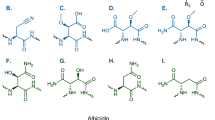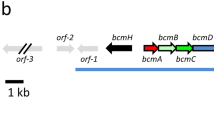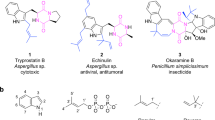Abstract
The side chain of the antifungal antibiotic ansatrienin A from Streptomyces collinus contains a cyclohexanecarboxylic acid (CHC)-derived moiety. This moiety is also observed in trace amounts of ω-cyclohexyl fatty acids (typically less than 1% of total fatty acids) produced by S. collinus. Coenzyme A-activated CHC (CHC-CoA) is derived from shikimic acid through a reductive pathway involving a minimum of nine catalytic steps. Five putative CHC-CoA biosynthetic genes in the ansatrienin biosynthetic gene cluster of S. collinus have been identified. Plasmid-based heterologous expression of these five genes in Streptomyces avermitilis or Streptomyces lividans allows for production of significant amounts of ω-cyclohexyl fatty acids (as high as 49% of total fatty acids). In the absence of the plasmid these organisms are dependent on exogenously supplied CHC for ω-cyclohexyl fatty acid production. Doramectin is a commercial antiparasitic avermectin analog produced by fermenting a bkd mutant of S. avermitilis in the presence of CHC. Introduction of the S. collinus CHC-CoA biosynthetic gene cassette into this organism resulted in an engineered strain able to produce doramectin without CHC supplementation. The CHC-CoA biosynthetic gene cluster represents an important genetic tool for precursor-directed biosynthesis of doramectin and has potential for directed biosynthesis in other important polyketide-producing organisms.
This is a preview of subscription content, access via your institution
Access options
Subscribe to this journal
Receive 12 print issues and online access
$209.00 per year
only $17.42 per issue
Buy this article
- Purchase on Springer Link
- Instant access to full article PDF
Prices may be subject to local taxes which are calculated during checkout





Similar content being viewed by others
References
Katz, L. Manipulation of modular polyketide synthases. Chem. Rev. 97, 2557–2575 (1997).
Zhao, L., Sherman, D.H. & Liu, H.-w. Biosynthesis of desosamine: molecular evidence suggesting β-glycosylation as a self-resistance mechanism in methymycin/neometymycin producing strain, Streptomyces venezulae. J. Amer. Chem. Soc. 120, 9374–375 (1998).
Aparico, J.F. et al. Organization of the biosynthetic gene cluster for rapamycin in Streptomyces hygroscopicus: analysis of the enzymatic domains in the modular polyketide synthase. Gene 169, 9–16 (1996).
Stassi, D.L. et al. Ethyl-substituted erythromycin derivatives produced by directed metabolic engineering. Proc. Natl. Acad. Sci. USA 95, 7305–7309 (1998).
McDaniel, R. et al. Multiple genetic modifications of the erythromycin polyketide synthase to produce a library of novel “unnatural” natural products. Proc. Natl. Acad. Sci. USA 96, 1846–1851 (1999).
Moore, B.S. et al. Biosynthetic studies on ansatrienin A. Formation of the cyclohexanecarboxylic acid moiety. J. Am. Chem. Soc. 115, 1577–1578 (1993).
Wang, P. et al. Cloning and characterization of the gene encoding 1-cyclohexenylcarbonyl CoA reductase from Streptomyces collinus. J. Bacteriol. 178, 6873–6881 (1996).
Chen, S. et al. Biosynthesis of ansatrienin (mycotrienin) and naphthomycin. Identification and analysis of two separate biosynthetic gene clusters in Streptomyces collinus Tu 1892. Eur. J. Biochem. 261, 98–107 (1999).
McArthur, H. A. I. A novel avermectin, doramectin–a successful application of mutasynthesis. In Developments in industrial microbiology—BMP '97 (eds Hutchinson, C.R. & McAlpine, J.) 43–48 (Society for Industrial Microbiology, Fairfax, VA, 1998).
Denoya, C. D. et al. A second branched-chain alpha-keto acid dehydrogenase gene cluster (bkdFGH) from Streptomyces avermitilis: its relationship to avermectin biosynthesis and construction of a bkdF mutant suitable for production of novel antiparasitic avermectins. J. Bacteriol. 177, 3504–3511 (1995).
He, X.Y., Yang, S.Y. & Schulz, H. Cloning and expression of the fadH gene and characterization of the gene product 2,4-dienoyl coenzyme A reductase from Escherichia coli. Eur. J. Biochem. 248, 516–520 (1997).
Moore, B.S., Poralla, K. & Floss, H.G. Biosynthesis of the cyclohexanecarboxylic acid starter unit of ω-cyclohexyl fatty acids in Alicyclobacillus acidocaldarius. J. Amer. Chem. Soc. 115, 5267–5274 (1993).
Cropp, T.A. et al. Fatty acid biosynthesis in a branched chain α-keto acid dehydrogenase mutant of Streptomyces avermitilis. Can. J. Microbiol. 46, 506–514 (2000).
Patton, S.M., Cropp, T.A. & Reynolds, K.A. A novel Delta(3),Delta(2)-enoyl-CoA isomerase involved in the biosynthesis of the cyclohexanecarboxylic acid-derived moiety of the polyketide ansatrienin A. Biochemistry 39, 7595–7604 (2000).
Dutton, C.J. et al. Novel avermectins produced by mutational biosynthesis. J. Antibiot. (Tokyo) 44, 357–365 (1991).
Jacobson, J.R., Hutchinson, C.R., Cane, D.E. & Khosla, C. Precursor-directed biosynthesis of erythromycin analogs by an engineered polyketide synthase. Science 277, 367–369 (1997).
Khaw, L.E., Bohm, G.A., Metcalfe, S., Staunton, J. & Leadlay, P.F. Mutational biosynthesis of novel rapamycins by a strain of Streptomyces hygroscopicus NRRL 5491 disrupted in rapL, encoding a putative lysine cyclodeaminase. J. Bacteriol. 180, 809–814 (1998).
Marsden, A.F. A. et al. Engineering broader specificity into an antibiotic- producing polyketide synthase. Science 279, 199–202 (1998).
Sambrook, J., Fritsch, E.F. & Maniatis, T. Molecular cloning: a laboratory manual, Edn. 2. (Cold Spring Harbor Laboratory Press, Cold Spring Harbor, NY; 1989).
Schmitt-John, T. & Engels, J.W. Promoter constructions for efficient secretion expression in Streptomyces lividans. Appl. Microbiol. Biotechnol. 36, 493–498 (1992).
Hopwood, D.A. et al. Genetic manipulation of streptomycetes, a laboratory manual. (John Innes Institute, Norwich, UK; 1985).
MacNeil, D.J. & Klapko, L.M. Transformation of Streptomyces avermitilis by plasmid DNA. J. Ind. Microbiol. 2, 209–218 (1987).
Wallace, K.K., Zhao, B., McArthur, H.A.I. & Reynolds, K.A. In vivo analysis of straight-chain and branched-chain fatty acid biosynthesis in three actinomycetes. FEMS Microbiol. Letts. 131, 227–234 (1995).
Acknowledgements
We thank Ron Fedechcko and Hamish McArthur at Pfizer, for providing doramectin and for carrying out LC-MS analyses of the S. avermitilis/pAC12 fermentations. We also thank Claudio Denoya (Pfizer) for advice for working with the bkd mutant of S. avermitilis. We thank Stephanie Patton for carrying out 2-cyclohexenylcarbonyl CoA isomerase assays. This work was supported in part by a grant from the National Science Foundation (MCB 9418581).
Author information
Authors and Affiliations
Corresponding author
Rights and permissions
About this article
Cite this article
Cropp, T., Wilson, D. & Reynolds, K. Identification of a cyclohexylcarbonyl CoA biosynthetic gene cluster and application in the production of doramectin. Nat Biotechnol 18, 980–983 (2000). https://doi.org/10.1038/79479
Received:
Accepted:
Issue Date:
DOI: https://doi.org/10.1038/79479
This article is cited by
-
Genome-scale analysis of genetic regulatory elements in Streptomyces avermitilis MA-4680 using transcript boundary information
BMC Genomics (2022)
-
Engineering actinomycetes for biosynthesis of macrolactone polyketides
Microbial Cell Factories (2019)
-
Designed biosynthesis of 25-methyl and 25-ethyl ivermectin with enhanced insecticidal activity by domain swap of avermectin polyketide synthase
Microbial Cell Factories (2015)
-
Genetic manipulation of the biosynthetic process leading to phoslactomycins, potent protein phosphatase 2A inhibitors
Journal of Industrial Microbiology & Biotechnology (2006)
-
Mutational biosynthesis—a tool for the generation of structural diversity in the biosynthesis of antibiotics
Applied Microbiology and Biotechnology (2005)



